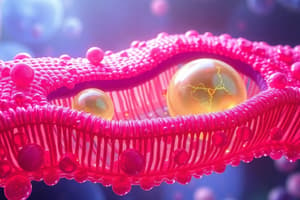Podcast
Questions and Answers
What characteristic of the plasma membrane primarily allows it to maintain fluidity when influenced by temperature changes?
What characteristic of the plasma membrane primarily allows it to maintain fluidity when influenced by temperature changes?
- The concentration of carbohydrates
- The composition of membrane proteins
- The ratio of saturated to unsaturated fatty acids (correct)
- The presence of phosphate groups
Which of the following statements about cholesterol within the plasma membrane is true?
Which of the following statements about cholesterol within the plasma membrane is true?
- Cholesterol acts as a carbohydrate in the membrane.
- Cholesterol increases membrane fluidity when present in large amounts.
- Cholesterol has no effect on membrane structure and function.
- Cholesterol decreases membrane fluidity, making it more rigid. (correct)
What type of membrane protein extends through the entire phospholipid bilayer?
What type of membrane protein extends through the entire phospholipid bilayer?
- Extrinsic protein
- Transmembrane protein (correct)
- Peripheral protein
- Integral protein
How do hydrophobic regions of integral proteins interact with the phospholipid bilayer?
How do hydrophobic regions of integral proteins interact with the phospholipid bilayer?
What is the primary component that makes up the majority of the plasma membrane structure?
What is the primary component that makes up the majority of the plasma membrane structure?
Which of the following correctly describes the structural role of extracellular structures?
Which of the following correctly describes the structural role of extracellular structures?
How does the fluid mosaic model describe cell membranes?
How does the fluid mosaic model describe cell membranes?
What is the primary function of proteoglycans in the extracellular matrix?
What is the primary function of proteoglycans in the extracellular matrix?
Which of the following processes is NOT a function of plasma membranes?
Which of the following processes is NOT a function of plasma membranes?
Turgor pressure is primarily maintained by which of the following mechanisms?
Turgor pressure is primarily maintained by which of the following mechanisms?
Flashcards are hidden until you start studying
Study Notes
Extracellular Structures
- Provide structural support and stability to cells through adhesion.
- Allow for filtering and regulating cellular functions.
- Composed primarily of cellulose in plant cells.
- Turgor pressure provides support to plant cells by maintaining internal fluid pressure.
- Extracellular Matrix (ECM) is rich in proteoglycans and collagen, which are essential for cell signaling and structure.
Cell Membranes
- Comprised of a phospholipid bilayer that is dynamic and fluid.
- Continuously undergo formation, movement, and fusion with other membranes, illustrated by the fluid mosaic model.
- Integral to processes such as information processing, energy transformation, and movement regulation.
- Phospholipids contain a hydrophilic phosphate head and hydrophobic fatty acid tails, affecting membrane fluidity.
- Saturated fatty acids lead to a less fluid membrane, while unsaturated fatty acids increase fluidity.
- Cholesterol modulates membrane fluidity; higher cholesterol content results in decreased fluidity.
- Integral membrane proteins span the entire membrane; peripheral proteins are associated but not embedded in the bilayer.
- Movement of membrane proteins is restricted by anchoring to the cytoskeleton.
Carbohydrates
- Carbohydrates associate with the plasma membrane by attaching to lipids or proteins.
- Formation of glycolipids (carbohydrate + lipid) and glycoproteins (carbohydrate + protein) is essential for cell recognition and signaling.
- Facilitate cell recognition by allowing specific binding between cells; this interaction is not permanent.
- Cell Adhesion involves more stable connections that hold cells together.
Cell Junctions
- Homotypic Binding: Cells adhere through identical receptor proteins.
- Heterotypic Binding: Different proteins on various cell types adhere to each other.
Types of Junctions
- Tight Junctions: Connect adjacent epithelial cells and restrict protein movement in the bilayer; prevent substances from passing through intercellular spaces.
- Desmosomes: Act as anchor points holding cells together through dense protein plaques, providing mechanical strength.
- Gap Junctions: Specialized connections allowing direct communication between cells through channels formed by connexins, enabling molecular exchange.
Studying That Suits You
Use AI to generate personalized quizzes and flashcards to suit your learning preferences.



